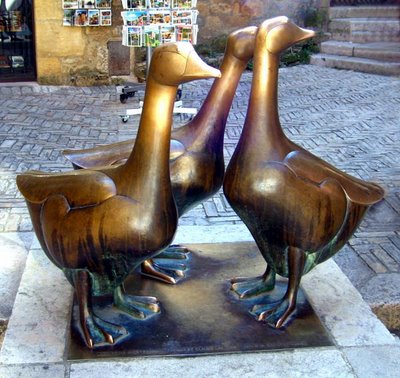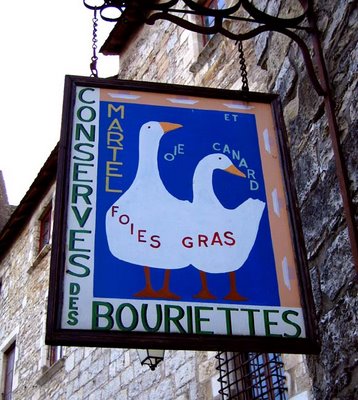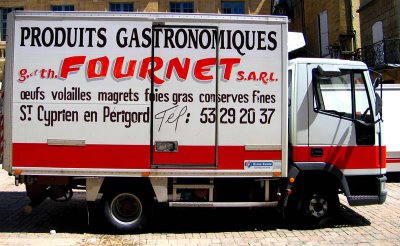 Oies de Toulouse, the local goose variety, that we saw on a farm near Sarlat.
Oies de Toulouse, the local goose variety, that we saw on a farm near Sarlat.These geese moved to attack me when I got too close with the camera.
I beat a hasty retreat but snapped a picture anyway.
But gussied-up seems to fit the place perfectly, since the expression looks like it might be derived from the word goose. Goosed up. Doesn't that make sense? (The dictionaries don't agree with me, by the way.) And the goose is the mascot of the whole Dordogne area, nay, of Southwestern France in general.
In culinary terms, France is divided into three big sections. In the north (Normandy, Brittany, Paris, Burgundy, the Loire Valley, etc.), the cooking medium of choice is butter, including cream. In Provence in the southeast, olive oil holds sway. And in the southwest (Perigord, Quercy, Gascogne, les Landes, among other areas), food is cooked in goose or duck fat.
When you go to Sarlat or Cahors or Rocamadour and look at restaurant menus, half of the entrées and plats are made with duck or goose in one form or another. Foie gras is the pinnacle of goose/duck cooking, but other dishes include goose or duck pâtés, duck breast (magret) grilled or pan-fried, confits de canard or d'oie (duck or goose preserved by slow cooking in duck or goose fat), and cassoulets (beans with duck or goose, pork, and sausages in a casserole).
Even if you don't go near a farm, you know that geese are a local obsession. As the Cadogan guide puts it, in the Dordogne "visitors are confronted everywhere by giant plywood geese, beckoning clients into tiny shops selling foie gras and confits."
I liked the fact that many of the signs in the Dordogne used the term foie gras in the plural. They don't sell foie gras that is like pâté or liver paste. They sell the livers themselves, individually. Foies gras are the real thing.
The fattening of geese and ducks to produce foie gras has been practiced since Roman times or longer. Force-feeding, or gavage, as the process is known, has become controversial, and several countries have banned the practice. It involves forcing the goose or duck to ingest many pounds of corn over a three-week period. The bird's liver fattens up and ends up weighing from a pound (a duck liver) to two pounds or more (a goose liver).
According to Cadogan, during their WWII occupation of France "the Nazis with their delicate sensibilities found the practice offensive and banned gavage, with the curious result of making foie gras a proud symbol of the [French] Resistance."
Personally, I like foie gras but it's a little too expensive for my retirement budget. And I especially like duck, which is almost a by-product of the foie gras industry. Last fall, as I wrote then, ducks called canards gras — fattened ducks, minus the liver — were on sale at very good prices in our supermarkets here in Saint-Aignan. Poached in a flavorful broth and then browned until golden in the oven, they were fantastic. Here's more information about cooking a duck.
We wandered around Sarlat for a couple of hours. Then we stumbled upon a restaurant called la Bedaine that had a good menu. What did we eat? Duck, of course. Along with Sarlat-style potatoes (sauteed in duck fat) and a salad with walnuts dressed with walnut oil. All local specialties.
 For sale in Sarlat: duck and goose liver pâtés, confit de canard and d'oie,
For sale in Sarlat: duck and goose liver pâtés, confit de canard and d'oie,and cassoulets, all in tins.
There's no escaping goose and duck in Sarlat or in the Dordogne. I'm sure local people don't eat nearly as much of it as you might think, though, from looking at the products on sale in the little shops in the touristy towns. There are also a lot of pizzerias in the area.










Isn't it nice to know that both duck and goose fat have about 70% of the cholesterol of butter!
ReplyDeletePeter, is it easy to find goose and duck fat for cooking in the U.S.?
ReplyDeleteAnother beautiful and complete post. I love Sarlat and know the three geese statue well. Nice job!
ReplyDeleteThis blog is great-- a really close-up-and-personal view of the Loire. Hope you don't mind, I linked you on my sidebar (http://rentvillas.blogspot.com).
ReplyDelete